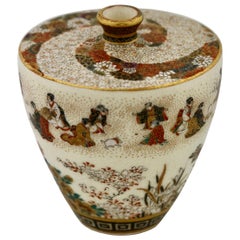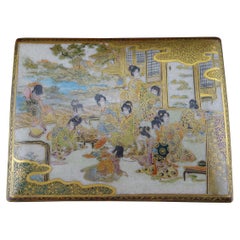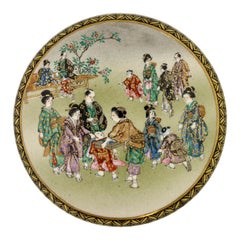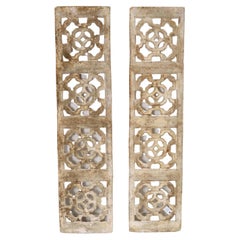Satsuma More Asian Art, Objects and Furniture
to
1
3
4
2
2
1
1
1
4
2
1
1
2
2
2
4
4
4
18
23
19
15
11
Creator: Satsuma
Pair of Satsuma Pedestals, 20th Century
By Satsuma
Located in CABA, AR
Enter the world of Japanese craftsmanship and elegance with this exquisite pair of Satsuma columns or pedestals. Satsuma ware, originating from the Sat...
Category
Mid-20th Century Japanese Satsuma More Asian Art, Objects and Furniture
Materials
Porcelain
$3,200 Sale Price / set
20% Off
Satsuma Earthenware Flat Shouldered Ovoid Vase, Garlic Mouth by Yabu Meizan
By Satsuma
Located in West Palm Beach, FL
A Satsuma earthenware flat shouldered ovoid vase with garlic mouth by Yabu Meizan,
Osaka, 1853-1934,
decorated in polychrome enamels and gilt over a cle...
Category
1890s Antique Satsuma More Asian Art, Objects and Furniture
Materials
Earthenware
Japanese Meiji Satsuma Finely Decorated and Gilded Scenic Box
By Satsuma
Located in Sarasota, FL
Japanese Meiji satsuma finely hand decorated and gilded box. The box depicts a different scene on each side. Marked with a maker's mark on the bottom.
Category
Late 19th Century Japanese Meiji Antique Satsuma More Asian Art, Objects and Furniture
Materials
Pottery
Satsuma Earthenware Covered Box, by Kinkozan
By Satsuma
Located in West Palm Beach, FL
A Satsuma Earthenware covered box,
by Kinkozan,
Japanese, Meiji period (1868-1912)
decorated in polychrome enamels and gilt over a clear, crackled glaze, delicately painted with s...
Category
Early 1900s Antique Satsuma More Asian Art, Objects and Furniture
Materials
Earthenware
Related Items
Mid-20th Century Cast Stone Architectural Panels, a Pair
Located in Morristown, NJ
20th C., cast stone panels with attractive patina. The panels could be used outdoors or for interior decoration. The back side of the panels have metal wall mounts.
Dimensions:
6...
Category
Mid-20th Century Unknown Chinoiserie Satsuma More Asian Art, Objects and Furniture
Materials
Cast Stone, Metal
Japanese Meiji Period (1868-1912) Satsuma Vase by Kinkozan
By Kinkozan
Located in Newark, England
JAPANESE SATSUMA PROCESSIONAL VASE
From our Japanese collection, we are delighted to introduce to the market this Japanese Satsuma Vase by Kinkozan. The vase with a compressed body ...
Category
Late 19th Century Japanese Meiji Antique Satsuma More Asian Art, Objects and Furniture
Materials
Ceramic, Earthenware, Pottery
A Fine Japanese Satsuma Vase . Meiji Period. Kinkozan
Located in London, GB
A Fine Japanese Satsuma Vase with Bijin, Peacock, and Chrysanthemums.
Attributed to Kinkozan Workshop, Kyoto, Meiji period (late 19th century)
Of pear-shaped form with a flared f...
Category
19th Century Japanese Antique Satsuma More Asian Art, Objects and Furniture
Materials
Ceramic, Porcelain
Satsuma Japanese Meiji Miniature Enameled Teapot Kozon Mark
By Satsuma
Located in Bishop's Stortford, Hertfordshire
An exceptional Japanese Satsuma miniature spool shaped pottery teapot and cover finely hand enameled with Kozon mark and dating from around 1880. This delightful teapot has an invers...
Category
19th Century Japanese Meiji Antique Satsuma More Asian Art, Objects and Furniture
Materials
Pottery
Magnificent Antique Japanese Satsuma Vase, Meiji Era, Signed
Located in London, GB
A fine antique Japanese Satsuma vase.
Meiji period. Signed.
A very nice 19th century Japanese Satsuma ware vase of a relatively ...
Category
Late 19th Century Japanese Antique Satsuma More Asian Art, Objects and Furniture
Materials
Ceramic, Porcelain
Pair of Blue Ground Japanese Satsuma Vases
By Satsuma
Located in Norwood, NJ
These are a very good quality pair of earthenware Japanese Satsuma vases, beautifully hand decorated and from the Meiji period, circa 1920. The vases have a hexangular shape raised o...
Category
Early 20th Century Japanese Meiji Satsuma More Asian Art, Objects and Furniture
Materials
Ceramic, Earthenware
Pair of Mid 20th Century Glazed Terracotta Foo Dogs
Located in Stamford, CT
Pair of mid 20th century glazed terracotta foo dogs with a great colors. This is a good looking pair of Foo Dogs and a nice size for any room. Foo ...
Category
Mid-20th Century Chinese Satsuma More Asian Art, Objects and Furniture
Materials
Terracotta
$3,400 Sale Price / set
20% Off
H 26.5 in W 17 in D 10.5 in
Unusual Pair of Japanese Meiji Period (1868-1912) Satsuma Vases by Kinkozan
By Kinkozan
Located in Newark, England
Taizan Yohei IX Style
From our Japanese collection we are delighted to offer this pair of Japanese Satsuma Vases by Kinkozan. The Satsuma Vases of baluster shape made from earthenwa...
Category
Early 1900s Japanese Meiji Antique Satsuma More Asian Art, Objects and Furniture
Materials
Ceramic, Earthenware, Pottery
$5,680
H 9.45 in Dm 4.93 in
Japanese Satsuma Dragon Vase, Meiji Period, c 1900, Japan
By Satsuma
Located in Austin, TX
A fantastic small Japanese Satsuma vase with image of writhing dragons, Meiji Period, circa 1900, Japan.
The vase of elegant baluster form, with a slightly flared foot, slender body...
Category
Early 1900s Japanese Meiji Antique Satsuma More Asian Art, Objects and Furniture
Materials
Ceramic, Porcelain, Pottery, Stoneware, Hardwood
Antique Satsuma One Thousand Faces and Dragon Meiji Period Baluster Shaped Vase
By Satsuma
Located in Tustin, CA
A very exquisite and elaborately detailed collectible antique hand made "A Thousand Faces" Japanese Satsuma earthenware pottery baluster shaped vase features intricately hand painted...
Category
19th Century Japanese Meiji Antique Satsuma More Asian Art, Objects and Furniture
Materials
Earthenware, Pottery
$1,595
H 7.25 in Dm 14 in
Japanese Satsuma Incense Burner, Koro, Meiji Period, Late 19th Century, Japan
Located in Austin, TX
A fine and elegant Japanese Satsuma tripod incense burner, koro, with pierced metal lid, signed Eizan (?) Meiji Period, late 19th century, Japan.
The koro, or censer, features a stoneware body of slightly compressed globular form, supported on three short and squat legs. The wide mouth with a recessed metal rim, and topped by an openwork metal lid topped with overlapping chrysanthemum blossoms of silver repousse.
The body of the koro finely painted with fan shaped cartouches. The fans in the foreground with sprays of blossoming chrysanthemum. The fans in the background with intricate geometric brocade designs.
The shoulder of the incense burner decorated with cartouches formed as stylized chrysanthemum petals, and intricately decorated with geometric and floral brocade designs.
The painting finely done in raised gilt and polychrome enamels, including the highly desirable gosu blue...
Category
Late 19th Century Japanese Meiji Antique Satsuma More Asian Art, Objects and Furniture
Materials
Silver, Metal
Satsuma Earthenware Vase and Cover, Japanese, Meiji Period
By Satsuma
Located in West Palm Beach, FL
A Satsuma Earthenware vase and cover,
Japanese, Meiji period, (1868-1912)
decorated in polychrome enamels and gilt over a clear, crackled glaze, delicately painted with samurai on ...
Category
1890s Antique Satsuma More Asian Art, Objects and Furniture
Materials
Ceramic
Satsuma more asian art, objects and furniture for sale on 1stDibs.
Satsuma more asian art, objects and furniture are available for sale on 1stDibs. These distinctive items are frequently made of ceramic and are designed with extraordinary care. There are many options to choose from in our collection of Satsuma more asian art, objects and furniture, although brown editions of this piece are particularly popular. Prices for Satsuma more asian art, objects and furniture can differ depending upon size, time period and other attributes — on 1stDibs, these items begin at $1,800 and can go as high as $13,500, while a piece like these, on average, fetch $3,625.
Questions About Satsuma More Asian Art, Objects and Furniture
- 1stDibs ExpertApril 5, 2022Satsuma porcelain or pottery includes a maker’s mark with the name of the person who made the item. Japanese numbers may also indicate that a Satsuma piece was part of a collection. Genuine Satsuma pieces will not have a “Made in Japan” label and should only include Japanese characters. When in doubt, work with a certified appraiser to determine the authenticity of your Satsuma piece. Find a variety of expertly vetted Satsuma porcelain and pottery collectibles on 1stDibs.
- Is Satsuma pottery valuable?1 Answer1stDibs ExpertApril 26, 2024Yes, some Satsuma pottery is valuable. The age, type, style and condition will determine how much a particular piece is worth. In addition, the history of ownership may also make a piece more valuable. For example, if a piece was previously in the collection of a notable person, such as a member of the Japanese Imperial Family, it may be worth more. To get an estimated value for a particular piece, consult a certified appraiser or knowledgeable antiques dealer. Find a range of Satsuma pottery on 1stDibs.
- 1stDibs ExpertOctober 7, 2024The difference between Satsuma and moriage is that the former is a type of pottery, and the latter is a technique for decorating pottery. Satsuma pottery is the term for earthenware pottery from Japan's Satsuma region. Although there are different styles, the most common element of Satsuma pottery is a heavy, dark glaze. Moriage is the term for when potters add raised slip decorations to pottery, creating a three-dimensional effect. Some Satsuma pieces show off moriage details, while others do not. Shop a range of Satsuma pottery on 1stDibs.
- How do I date a Satsuma vase?1 Answer1stDibs ExpertMarch 22, 2022To date a Satsuma vase, study its mark. Vases made before World War II normally feature a mark in Japanese. A vase that says "Royal Satsuma" likely dates back to the late 20th century. You'll find a variety of expertly vetted Satsuma vases on 1stDibs.
- What is a Japanese Satsuma vase?1 Answer1stDibs ExpertOctober 12, 2021A type of Japanese pottery originated from Satsuma province in Japan is termed as Satsuma ware. A vase of this kind is known as a Satsuma vase. An interesting fact about Satsuma ware is that they feature a "makers mark" or marking as a key to help collectors unlock the value, age and authenticity of the piece. Shop a range of antique and vintage Japanese vases on 1stDibs.
- 1stDibs ExpertNovember 4, 2024To identify Satsuma pottery marks, you'll typically need to perform research using trusted online resources. Satsuma is a region in Japan known for its pottery, and many factories and artisans have operated there, including Kinkozan, Taizan, Yasuda, Choshuzan, Fuzan, Gyozan, Koshida and Maruni Kobe. Each maker has its own marks associated with it, and these typically are in Japanese kanji characters. You can compare the characters on your piece to pictures shared online to find a match. Alternatively, a certified appraiser or experienced antique dealer can help you identify your pottery markings. On 1stDibs, shop a selection of Satsuma pottery.
- 1stDibs ExpertFebruary 1, 2024One way to tell if your Satsuma vase is valuable is to look for markings on it. The oldest and typically most expensive pieces will usually have the Shimazu family crest — a circle with a cross through it — hand-painted on the bottom. If the piece is stamped with the marking or says "Made in Japan" in the Roman alphabet, it is a newer vase. Factors like the style of the vase and its condition will also impact its price. It's a good idea to have a certified appraiser or knowledgeable dealer evaluate your vase to determine its value. Find a variety of Satsuma vases on 1stDibs.
- 1stDibs ExpertSeptember 9, 2024Yes, some Satsuma pottery is worth something. Depending on their age, maker, type, style, condition and other factors, pieces may sell for a few hundred to several thousand dollars. Looking at sales and auction histories can give you a rough idea of the value of a piece. For a more definitive valuation, use the services of a certified appraiser or knowledgeable antique dealer. On 1stDibs, explore a collection of Satsuma pottery.





